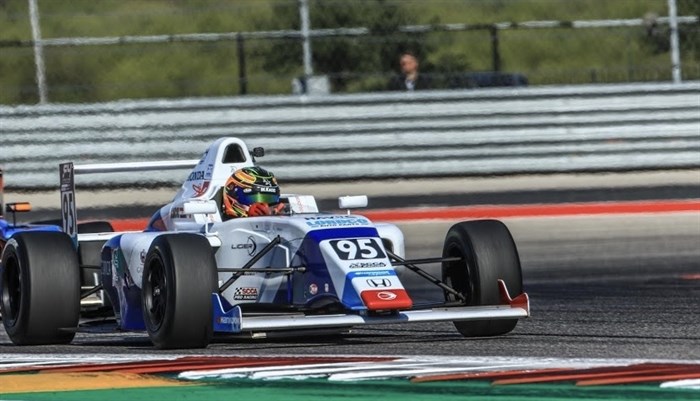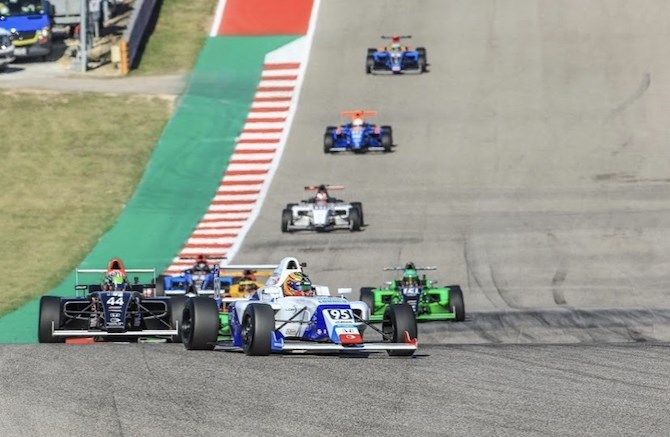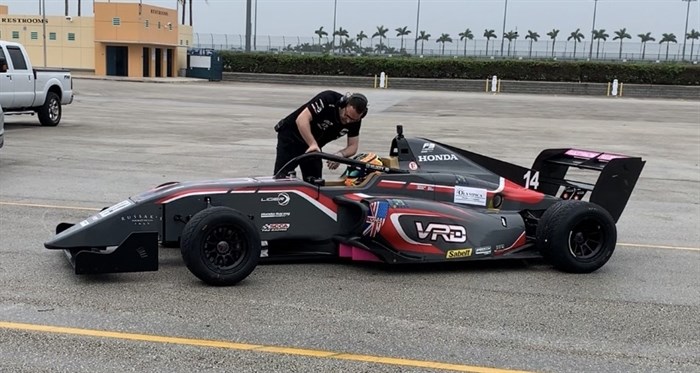
Kelowna's Marco Kacic was the U.S. champion F4 race car driver in 2019.
Image Credit: Submitted/Danny Kacic
May 26, 2020 - 7:00 AM
Marco Kacic can’t legally drive alone on the streets of Kelowna but he can power a Formula 4 race car down a circuit straightaway at more than 250 km/h.
He turned 17 in February but, because of COVID-19, he can’t get his N as a new driver and still needs to be accompanied by a parent, despite winning the 2019 Formula Pro USA champion last year, driving an F4 race car to first place in seven out of the 10 races in the series. He won his first ever F4 race that year by 27 seconds.

Marco Kacic
Image Credit: Submitted/Danny Kacic
“I like to think it was practice or work ethic, I don’t know,” he said when asked how he managed to get so good. “At the end of the day, I showed up there and did my absolute best in every race. Between races, I trained or worked at sport school to get better.”
The sport school he’s referring to is the Canadian Sports School that operates in Kelowna as well as Penticton and a similar one in Kamloops. It’s mostly designed to help cross-train high school athletes aiming for the Olympics but Kacic qualified because becoming an F1 champion driver – which is his goal – requires a surprising amount of athletic endurance.
That training, he believes, helped him dominate the F4 circuit. While he works out four times a week, other drivers at that level may work out only on one or two days each week, he said.
Why does sitting down driving a race car require such a high level of athleticism?
“When you think about the way your body has to work when you’re driving the car, it’s crazy,” Kacic said. “Imagine putting yourself in an extremely hot condition, having to tense up every muscle in your body for a few seconds and then release it and repeat for 30 minutes while having to keep a perfect mindset. On top of that, you have the weight of the steering wheel and the weight of the helmet.”

Driving race cars requires a high level of athleticism.
Image Credit: Submitted/Danny Kacic
Keeping a “perfect mindset” is something he’s been working on since his father, Danny, introduced him to “baby kart” driving when he was five years old.
At that time, Danny had a business selling and servicing the karts so Marco went with him to racetracks all over North America.
Since champion drivers start very young, Danny gave Marco a kart to try when he was five, just to see if he liked it. He did.
Baby karts are powered by gas motors with a top speed equivalent to someone running, Kacic said.
When he was eight, he qualified to move up to karts that have speeds of up to 80 km/h and could legally race. It’s been a steady climb through different levels since then to the F4, with a top speed of almost 260 km/h.
“It’s not even the speed in the straight line that I always loved about racing,” Kacic said. “It was the cornering speed – the fact that you can roll through a corner so much faster than you ever think you could, or the passing. It’s the battle, that’s always been my favourite part of racing.”
Starting young is vital in order to learn “race craft,” which is something Kacic said cannot be taught. This is how he described it:
“When you’re behind someone, it’s how you get by them. When they’re behind you, how do you stop them from getting by you? It becomes a chess game real fast – knowing when to move, when to pass. If you pass in the wrong place you’ll lose speed and they’ll pass you right back. It’s something that can’t be taught just like that, it has to be learned over years and years. That’s a big reason drivers start so young in karts, to learn the race craft and to learn the basics.”

That's Marco Kacic in car 95 leading the 2019 field in U.S. F4 racing.
Image Credit: Submitted/Danny Kacic
While COVID-19 has put the skids on this racing season, it hasn’t stopped him from competing.
Now he’s in regular simulator races with drivers from around the world. He says he’s not as good on a simulator but he’s still usually in the top five. He goes to Kartplex in Oliver to keep his hand in on a real vehicle and he’s doing a couple of Zoom sessions each week with the Canadian Sports School to keep up his fitness training.
He’s also looking for a sponsor so he can move up to the F3 series this year – if any races do run. He has tried out an F3 and is focused on taking that next step in his progress to the top.
“I always like to set a goal, work towards it and accomplish it,” Kacic said. “In racing, that’s basically what it is. Every weekend you set a goal for how you’re going to win this race. All week you work your butt off to try to make that happen. When it’s over, then there’s the next race and you work towards that one. It’s a constant mission to do better. That’s what I enjoy most about it.”
As for driving the family car, that takes some adjustment.
“You still have to learn it, like anyone else,” he said. “It’s so different from racing. I jumped in and I could drive the car right away. But I still had to learn the rules of the road and work with other people on the road.”
Does he have to restrain himself from stomping on the gas pedal?
“Definitely,” he said. “But, I’ll get used to it.”
After all, speeding tickets don’t fit into his already stretched budget.
For more on Kacic, go to his web page here.
For more on fitness levels of F1 drivers, go here.

Marco Kacic trying out an F3 racing car.
Image Credit: Submitted/Danny Kacic
To contact a reporter for this story, email Rob Munro or call 250-808-0143 or email the editor. You can also submit photos, videos or news tips to the newsroom and be entered to win a monthly prize draw.
We welcome your comments and opinions on our stories but play nice. We won't censor or delete comments unless they contain off-topic statements or links, unnecessary vulgarity, false facts, spam or obviously fake profiles. If you have any concerns about what you see in comments, email the editor in the link above.
News from © iNFOnews, 2020